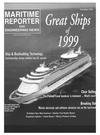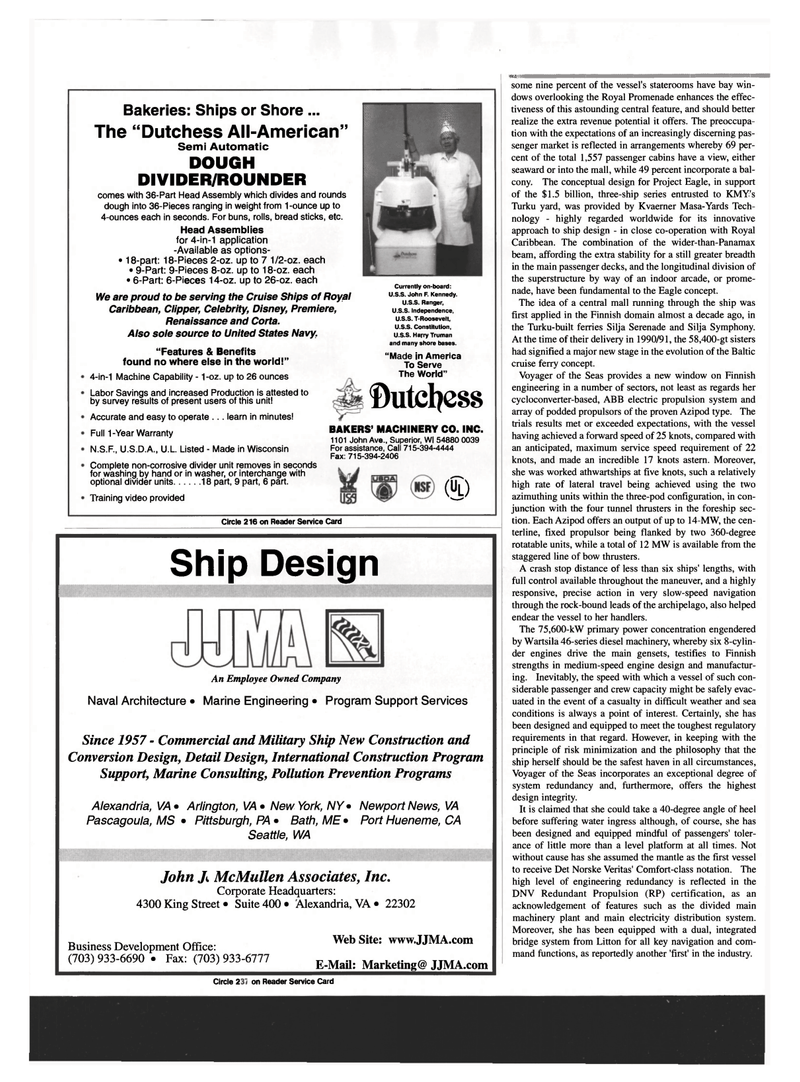
Page 32: of Maritime Reporter Magazine (December 1999)
Read this page in Pdf, Flash or Html5 edition of December 1999 Maritime Reporter Magazine
Bakeries: Ships or Shore ...
The "Dutchess All-American"
Semi Automatic
DOUGH
DIVIDER/ROUNDER comes with 36-Part Head Assembly which divides and rounds dough into 36-Pieces ranging in weight from 1-ounce up to 4-ounces each in seconds. For buns, rolls, bread sticks, etc.
Head Assemblies for 4-in-1 application -Available as options- • 18-part: 18-Pieces 2-oz. up to 7 1/2-oz. each • 9-Part: 9-Pieces 8-oz. up to 18-oz. each • 6-Part: 6-Pieces 14-oz. up to 26-oz. each
We are proud to be serving the Cruise Ships of Royal
Caribbean, Clipper, Celebrity, Disney, Premiere,
Renaissance and Corta.
Also sole source to United States Navy. "Features & Benefits found no where else in the world!" 4-in-1 Machine Capability - 1-oz. up to 26 ounces
Labor Savings and increased Production is attested to by survey results of present users of this unit!
Accurate and easy to operate . . . learn in minutes!
Full 1-Year Warranty
N.S.F., U.S.D.A., U.L. Listed - Made in Wisconsin
Complete non-corrosive divider unit removes in seconds for washing by hand or in washer, or interchange with optional divider units 18 part, 9 part, 6 part.
Training video provided
Currently on-board:
U.S.S. John F. Kennedy.
U.S.S. Ranger,
U.S.S. Independence,
U.S.S. T-Roosevelt,
U.S.S. Constitution,
U.S.S. Harry Truman and many shore bases. "Made in America
To Serve
The World" ©utcljess
BAKERS' MACHINERY CO. INC. 1101 John Ave., Superior, Wl 54880 0039
For assistance, Call 715-394-4444
Fax: 715-394-2406
Circle 216 on Reader Service Card
Ship Design
An Employee Owned Company
Naval Architecture • Marine Engineering • Program Support Services
Since 1957 - Commercial and Military Ship New Construction and
Conversion Design, Detail Design, International Construction Program
Support, Marine Consulting, Pollution Prevention Programs
Alexandria, VA • Arlington, VA • New York, NY• Newport News, VA
Pascagoula, MS • Pittsburgh, PA • Bath, ME • Port Hueneme, CA
Seattle, WA
John J. McMullen Associates, Inc.
Corporate Headquarters: 4300 King Street • Suite 400* Alexandria, VA • 22302
Business Development Office: (703)933-6690 • Fax: (703) 933-6777
Web Site: www.JJMA.com
E-Mail: Marketing@ JJMA.com 18 rf^HBi^BHHHHHHBHHHHHHHHHHB^HHHHHHHHHHIMHHHHHHHHeHHMnHI some nine percent of the vessel's staterooms have bay win- dows overlooking the Royal Promenade enhances the effec- tiveness of this astounding central feature, and should better realize the extra revenue potential it offers. The preoccupa- tion with the expectations of an increasingly discerning pas- senger market is reflected in arrangements whereby 69 per- cent of the total 1,557 passenger cabins have a view, either seaward or into the mall, while 49 percent incorporate a bal- cony. The conceptual design for Project Eagle, in support of the $1.5 billion, three-ship series entrusted to KMY's
Turku yard, was provided by Kvaerner Masa-Yards Tech- nology - highly regarded worldwide for its innovative approach to ship design - in close co-operation with Royal
Caribbean. The combination of the wider-than-Panamax beam, affording the extra stability for a still greater breadth in the main passenger decks, and the longitudinal division of the superstructure by way of an indoor arcade, or prome- nade, have been fundamental to the Eagle concept.
The idea of a central mall running through the ship was first applied in the Finnish domain almost a decade ago, in the Turku-built ferries Silja Serenade and Silja Symphony.
At the time of their delivery in 1990/91, the 58,400-gt sisters had signified a major new stage in the evolution of the Baltic cruise ferry concept.
Voyager of the Seas provides a new window on Finnish engineering in a number of sectors, not least as regards her cycloconverter-based, ABB electric propulsion system and array of podded propulsors of the proven Azipod type. The trials results met or exceeded expectations, with the vessel having achieved a forward speed of 25 knots, compared with an anticipated, maximum service speed requirement of 22 knots, and made an incredible 17 knots astern. Moreover, she was worked athwartships at five knots, such a relatively high rate of lateral travel being achieved using the two azimuthing units within the three-pod configuration, in con- junction with the four tunnel thrusters in the foreship sec- tion. Each Azipod offers an output of up to 14-MW, the cen- terline, fixed propulsor being flanked by two 360-degree rotatable units, while a total of 12 MW is available from the staggered line of bow thrusters.
A crash stop distance of less than six ships' lengths, with full control available throughout the maneuver, and a highly responsive, precise action in very slow-speed navigation through the rock-bound leads of the archipelago, also helped endear the vessel to her handlers.
The 75,600-kW primary power concentration engendered by Wartsila 46-series diesel machinery, whereby six 8-cylin- der engines drive the main gensets, testifies to Finnish strengths in medium-speed engine design and manufactur- ing. Inevitably, the speed with which a vessel of such con- siderable passenger and crew capacity might be safely evac- uated in the event of a casualty in difficult weather and sea conditions is always a point of interest. Certainly, she has been designed and equipped to meet the toughest regulatory requirements in that regard. However, in keeping with the principle of risk minimization and the philosophy that the ship herself should be the safest haven in all circumstances,
Voyager of the Seas incorporates an exceptional degree of system redundancy and, furthermore, offers the highest design integrity.
It is claimed that she could take a 40-degree angle of heel before suffering water ingress although, of course, she has been designed and equipped mindful of passengers' toler- ance of little more than a level platform at all times. Not without cause has she assumed the mantle as the first vessel to receive Det Norske Veritas' Comfort-class notation. The high level of engineering redundancy is reflected in the
DNV Redundant Propulsion (RP) certification, as an acknowledgement of features such as the divided main machinery plant and main electricity distribution system.
Moreover, she has been equipped with a dual, integrated bridge system from Litton for all key navigation and com- mand functions, as reportedly another 'first' in the industry. 34 Circle 215 on Reader Service Card

 31
31

 33
33
